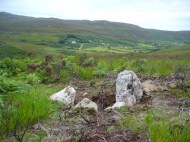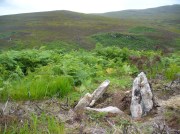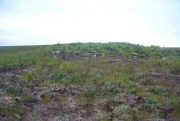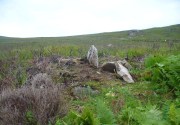Chambered Cairn: OS Grid Reference – NC 5652 6300
Also Known as:
Along the A838 road between Tongue and Durness, just over the Tongue bridge take the first right to Melness, Skinnet and beyond. Pass the previously unrecorded West Strathan petroglyph and go right to the end of the road. Walk down the path and cross the river, heading then up the diagonal path onto the moors. Approaching level ground, look back down to the river and head south across the moorland towards the fence. As you near where the fencing approaches the river, zigzag about and you’ll find it amidst a cluster of bracken in the heather.
Archaeology & History
This apparent Neolithic chambered structure is pretty much in ruins and, by the look of things, has been severely robbed of much earth and stone at some time in the not-too-distant past. A relatively small artificial platform of stone and earth in roughly circular form can be discerned when the heather or bracken is low, but much of the large mound that was built here has long since been dismantled. Instead, we have remnants of an internal stone chamber, consisting of a small upright monolith with an adjoining stone roughly at right-angle, with another small but elongated stone running roughly parallel with it – creating a small stone ‘U’-shaped chamber.
When Tom Welsh (1973) came to write about the site, “100m from east bank of Strath Melness Burn,” he described it as follows:
“remains of a circular cairn, diameter 16m, with 8 visible kerb-stones. Perimeter flattened on W side while cairn material curves inwards in the manner of a facade. Leading from this for 4m into the cairn is a slightly curving depression, with two large displaced slabs lying across entrance. 2m further in is a rectangular cist, 1.75 x 0.8m, with 4 slabs in situ. At E end a slab 0.80m long, 0.12m thick has adjoining it at right angles the only slab on the N side, 0.40m long and 0.25m thick. The angle is supported by an embedded stone 0.40 x 0.12m. Forming the S side of the cist are slabs 0.50 x 0.10 and 0.89 x 0.12m. On perimeter of cairn, E side, is a small stone with a socket mark 0.04m diameter 0.025m deep.”
If you walk away from the remains of this small chamber, you’ll see a scatter of stones here and there around the edges, defining how the cairn used to be. But unless you’re a real chambered tomb fanatic, this isn’t worth too much attention. It almost seems that it will fall beneath moorland debris in the coming century, perhaps never to be seen again…..
References:
- Welsh, Thomas C., “Dalvraid, chambered cairn”, in Discovery & Excavation Scotland, 1973
© Paul Bennett, The Northern Antiquarian



